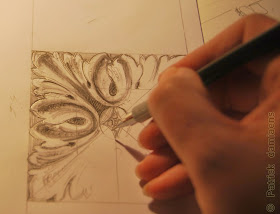Patrick Damiaens
Ornamental Woodcarver
CARVING A ROSETTE IN WOOD
Rosette, Ornament
A rosette is a practical ornament, for which the possibilities for application are nearly endless. This ornament can already be found in the time of the ancient Greeks and Romans, where it is mainly used as an architectural decoration.
In the Netherlands,
the term rosette is commonly used, but in Flanders, people also tend to refer
to the rosette as “Rosace”, a word originating from France.
In the
Gothic style period, this ornament can be found, for instance, as the keystone
of ribbed vaults. The rosette can be found throughout almost every style period
in history, each time embodying the specific features and characteristics of these
periods. But the period between 1750 and 1850 marks an era in which this
ornament became even more popular, resulting in a wider use and a more
imaginative variety of combinations and applications. It became a
distinguishing feature for the Louis XVI style.
Rosettes come in all shapes and sizes. Most common is a round-shaped rosette, but square, rectangular or even diamond-shaped rosettes aren’t that uncommon either.
As I mentioned before, this ornament was widely used during the Classicistic period (1750-1850). Classicism is a reaction to Baroque and Rococo and combines elements of Greek and Roman art or elements from the classical antiquity in general. The rosette is a separately placed flower-shaped ornament, with flower petals, acanthus leaves, oak leaves or even laurel leaves stretching outward from a central point.
There are more sophisticated rosette designs, which consist of a combination of several motifs (e.g. a combination of acanthus leaves and laurel leaves) and then there’s the twisted rosette design, which consists of various types of leaf motifs as well.
From the 17th century onward we notice that rosettes are often used as a decorative ornament on tables and chairs. They can particularly be found on twisted wooden designs or on baluster-shaped legs and form the central part of the H- or X-shaped joints between the legs of tables or chairs. (See picture)
By the end of the 18th century, during the French classicistic Louis XVI style period, this ornament is widely applied to furniture and other interior elements. It is used so often that it becomes a characteristic feature of this period.
Below you will find a short impression of the carving of this ornament. The design for this rosette was provided by the client, which is quite common practice. The design is inspired by an existing piece of furniture, which was carved in walnut.
Rosettes come in all shapes and sizes. Most common is a round-shaped rosette, but square, rectangular or even diamond-shaped rosettes aren’t that uncommon either.
 |
| Several rosettes, Don Bosco Liège |
As I mentioned before, this ornament was widely used during the Classicistic period (1750-1850). Classicism is a reaction to Baroque and Rococo and combines elements of Greek and Roman art or elements from the classical antiquity in general. The rosette is a separately placed flower-shaped ornament, with flower petals, acanthus leaves, oak leaves or even laurel leaves stretching outward from a central point.
There are more sophisticated rosette designs, which consist of a combination of several motifs (e.g. a combination of acanthus leaves and laurel leaves) and then there’s the twisted rosette design, which consists of various types of leaf motifs as well.
 |
| Rosette ,this ornament is typical Louis XVI style, Versailles |
From the 17th century onward we notice that rosettes are often used as a decorative ornament on tables and chairs. They can particularly be found on twisted wooden designs or on baluster-shaped legs and form the central part of the H- or X-shaped joints between the legs of tables or chairs. (See picture)
By the end of the 18th century, during the French classicistic Louis XVI style period, this ornament is widely applied to furniture and other interior elements. It is used so often that it becomes a characteristic feature of this period.
Below you will find a short impression of the carving of this ornament. The design for this rosette was provided by the client, which is quite common practice. The design is inspired by an existing piece of furniture, which was carved in walnut.
CARVING A ROSETTE,various stages
________________________
________________
 |
| Rosette in wood | First a design is created |
 |
| Rosette in wood | The design will be redrawn on tracing paper and transferred to the wood |
 |
| Modeling can begin |
 |
| Rosette | With a pencil, the correct contour and details are applied back on to the wood |
 |
| Rosette in wood | Finishing, the application of the detail |
 |
| A Rosette in wood | Hand Carved Wood Rosettes |





No comments:
Post a Comment